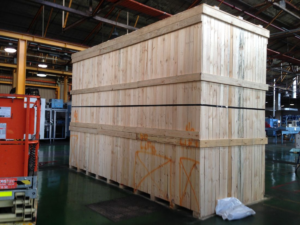Wooden packing crates vs plastic – here’s why wooden is best!
 Compared to their plastic versions, timber packing crates are far superior. The most common material for shipping, wood is recyclable, repairable, able to hold larger weights and cost you less. Here are ten reasons why the best choice is always wood.
Compared to their plastic versions, timber packing crates are far superior. The most common material for shipping, wood is recyclable, repairable, able to hold larger weights and cost you less. Here are ten reasons why the best choice is always wood.
1. They cost you less. Plastic packing crates are more expensive – they can cost almost three times as much wood versions and, once they’re damaged, are not easy to repair, so if something goes wrong during transport you will lose your investment.
2. They’re better for overseas trips. If you regularly ship your goods overseas, you’re unlikely to get your crates back. In that case, it’s a better bet to use wooden shipping crates over plastic.
3. Great for food transportation. Despite claims to the contrary, wood is just as hygienic (if not more so) as plastic when used to ship food goods. Recent scientific research shows that its anti-bacterial properties work well for all kinds of food, including seafood and meats, vegetables and fruit. However, solid food should be shipped in crates made of poplar, beech, walnut and elm only. There is no scientific evidence to demonstrate that plastic containers are superior to wood for food transportation – their popularity with manufacturers is merely an erroneous prejudice.
4. They’re easier to stack. Because wooden shipping crates are so widely used throughout the shipping industry, loading them and stacking them is more space and cost-effective because the uniform shapes lead to easier handling. They have more robust sides, too – and that means your valuable items are better protected.
5. Safer for the environment. Plastic crates are made from oil, which means they’ll need to be melted before recycling. Wood is a sustainable natural resource that can be used and repaired again and again – hence they’re a more green choice.
6. They can bear more weight. Plastic crates are best for shipments weighing 680 kilos or less. Wooden shipping crates are more suitable for heavy items weighing up to 1360 kilos. They also aren’t easily crushed, so they make the perfect solution for transporting delicate goods and awkward loads.
7. They’re weather resistant. There’s an excellent reason why wooden shipping crates have been used for freight for centuries – wood is a naturally weather-resistant material that keeps your precious products drier, even when exposed to seawater.
8. They don’t conduct heat. Packing crates fashioned from timber rarely hold heat like other materials, so if you’re shipping goods that can spoil at high temperatures, wood is the way to go.
9. You can customise them. If you’re transporting items of unusual size or shape, it’s easier to get a crate tailored to your needs. Because plastic crates are injection moulded, it can be tricky and cost-prohibitive to specify a size and shape just for you.
10. You can store them for longer. When you need to warehouse your goods for a more extended period, a wooden shipping crate will naturally resist water seepage, air contamination and other factors that could cause your products to degrade over time.
11. Customisable. Because some packaging companies make crates out of wood, the can be customized to suit the kind of product that you are moving. This will satisfy a range of products so you can safely move your goods no matter their size or shape.


